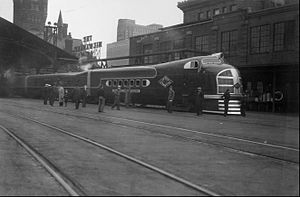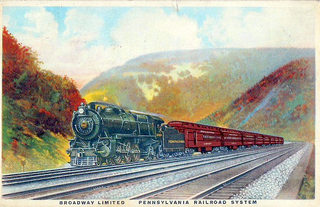
The Broadway Limited was a passenger train operated by the Pennsylvania Railroad (PRR) between New York City and Chicago. It operated from 1912 to 1995. It was the Pennsylvania's premier train, competing directly with the New York Central Railroad's 20th Century Limited. The Broadway Limited continued operating after the formation of Penn Central (PC) in February 1968, one of the few long-distance trains to do so. PC conveyed the train to Amtrak in 1971, who operated it until 1995. The train's name referred not to Broadway in Manhattan, but rather to the "broad way" of PRR's four-track right-of-way along the majority of its route.

The City of Denver was a streamlined passenger train operated by the Union Pacific Railroad between Chicago, Illinois, and Denver, Colorado. It operated between 1936 and 1971. From 1936–1955 the Chicago and North Western Railway handled the train east of Omaha, Nebraska; the Chicago, Milwaukee, St. Paul and Pacific Railroad handled it thereafter. The train was the fastest long-distance train in the United States when it debuted in 1936, covering 1,048 miles (1,687 km) in 16 hours. For almost its entire career its principal competitor was the Chicago, Burlington and Quincy Railroad's Denver Zephyr. When Amtrak assumed operation of most intercity trains in the United States in 1971, it discontinued the City of Denver, preferring to use the Burlington's route between Chicago and Denver.
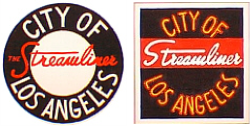
The City of Los Angeles was a streamlined passenger train between Chicago, Illinois, and Los Angeles, California via Omaha, Nebraska, and Ogden, Utah. Between Omaha and Los Angeles it ran on the Union Pacific Railroad; east of Omaha it ran on the Chicago and North Western Railway until October 1955 and on the Milwaukee Road thereafter. The train had number 103 westbound and number 104 eastbound.

Illinois Central 121 was a diesel streamliner built in 1936 by Pullman-Standard and powered by Electro-Motive Corporation, which was used by the Illinois Central Railroad on the Green Diamond. Its fixed five-car consist was also the end of an era; the popularity of the early streamliners was their undoing, because the trains could not be lengthened or shortened to handle varying loads. It was the last streamliner built with the power car articulated with the train; future streamliners featured a matched but separable locomotive. The train was painted in a two-tone green livery, "Cypress Green" on the nose and below the window sills with "Cedar Green" above, separated by an aluminum strip. Extensive aluminum trim was applied.

The Nebraska Zephyr was a streamlined passenger train operated by the Chicago, Burlington and Quincy Railroad between Chicago, Illinois; Omaha, Nebraska; and Lincoln, Nebraska, from 1947 to 1971. Until 1968, the service was provided by two Twin Cities Zephyr articulated trainsets — the "Train of the Gods" and "Train of the Goddesses" — that became synonymous with it. The Nebraska Zephyr was one of many trains discontinued when Amtrak began operations in 1971. The "Train of the Goddesses" set is preserved at the Illinois Railway Museum in Union, Illinois.

The Coast Daylight, originally known as the Daylight Limited, was a passenger train on the Southern Pacific Railroad (SP) between Los Angeles and San Francisco, California, via SP's Coast Line. It was advertised as the "most beautiful passenger train in the world," carrying a particular red, orange, and black color scheme. The train operated from 1937 until 1974, one of the few passenger trains retained by Amtrak in 1971. Amtrak merged it with the Coast Starlight in 1974.

The Denver Zephyr was a streamlined passenger train operated by the Chicago, Burlington and Quincy Railroad between Chicago, Illinois, and Denver, Colorado. In peak years it ran to Colorado Springs. It operated from 1936 to 1973. The Denver Zephyr continued operating after the Burlington Northern Railroad merger in 1970. BN conveyed the train to Amtrak in 1971; Amtrak merged it with the Denver-Oakland City of San Francisco to form the San Francisco Zephyr and dropped the "Denver" name in 1973.

The City of San Francisco was a streamlined through passenger train which ran from 1936 to 1971 on the Overland Route between Chicago, Illinois and Oakland, California, with a ferry connection on to San Francisco. It was owned and operated jointly by the Chicago and North Western Railway (1936–55), Chicago, Milwaukee, St. Paul and Pacific Railroad (1955-71), the Union Pacific Railroad, and the Southern Pacific Railroad. It provided premium extra fare service from Chicago to San Francisco when introduced in 1936 of 39 hr 45 min each way.

The Rocky Mountain Rocket was a streamlined passenger train of the Chicago, Rock Island and Pacific Railroad. Rock Island's train numbers 7 and 8 ran between Chicago's LaSalle Street Station and Denver's Union Station and Colorado Springs, Colorado. The Rocky Mountain Rocket ran from 1939 to 1966; the train was discontinued prior to the creation of Amtrak in 1971.
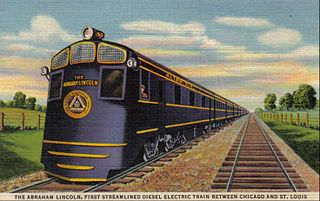
The Abraham Lincoln was a named passenger train operated by the Baltimore and Ohio Railroad from 1935 into the 1960s. The "Abe Lincoln" ran between Chicago and St. Louis on the B&O's subsidiary Alton Railroad. The train later passed to the Gulf, Mobile and Ohio Railroad, and then finally to Amtrak, which retained the name until 1978. Service between Chicago and St. Louis is now known by the umbrella term "Lincoln Service". This train was the first streamlined passenger service to travel the 284 miles between Chicago and St. Louis, with Joliet, Bloomington-Normal, Springfield and Alton in between. Passengers can get a glimpse of the Mississippi River between Alton and St. Louis.

The San Joaquin Daylight was a Southern Pacific passenger train inaugurated between Los Angeles and San Francisco's Oakland Pier by way of the San Joaquin Valley and Tehachapi Pass on July 4, 1941. Travel times were between 12 hours and 14 hours. It operated until the advent of Amtrak in 1971.

The Chicagoan and Kansas Cityan were a pair of American named passenger trains operated by the Atchison, Topeka and Santa Fe Railway. They ran from Chicago, Illinois to Wichita, Kansas, with a later extension to Oklahoma City.

The City of Kansas City was a streamlined passenger train operated by the Wabash Railroad and its successor the Norfolk and Western Railway between St. Louis and Kansas City, Missouri. It operated from 1947 to 1968. At the time of its introduction it was the only streamliner which operated entirely within the state of Missouri.

The City of Memphis was a 236.8-mile (381.1 km) passenger train route operated by the Nashville, Chattanooga and St. Louis Railway connecting Nashville's Nashville Union Station and Memphis, Tennessee's Memphis Union Station.

The City of Miami was a seven-car coach streamliner inaugurated by Illinois Central Railroad on December 18, 1940. Its route was from Chicago to Miami a total distance of 1,493 miles (2,403 km).
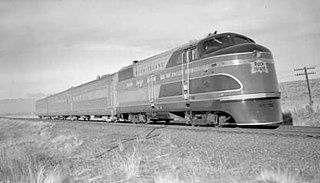
The Chicago, Rock Island and Pacific Railroad Rockets were lightweight, streamlined diesel-electric passenger trains built by the Budd Company. These six trains were the first streamlined equipment purchased by the Rock Island, as well as being its first diesel-powered passenger trains. Four of the trains consisted of three cars each, the other two each had four cars.

The Land O'Corn was a streamlined passenger train operated by the Illinois Central Railroad between Chicago, Illinois, and Waterloo, Iowa, from 1941 until 1967. Its inception was due in no small part to John W. Rath of Ackley, IA and part owner of the Rath Packing Co. of Waterloo, Iowa as well as a member of the Illinois Central's board of directors. It featured a wide range of equipment over its existence, including self-propelled Motorailers and steam locomotives, before finally adopting conventional diesel locomotives and lightweight cars. The Illinois Central discontinued the Land O'Corn in 1967; Amtrak later operated the Black Hawk over part of its route.
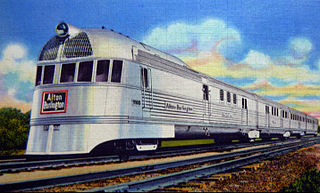
The Ozark State Zephyr was a streamlined passenger train operated by the Chicago, Burlington and Quincy Railroad (CB&Q) and the Alton Railroad between St. Louis and Kansas City in Missouri, home of the Ozarks. It operated from 1936 to 1939. The Zephyr was one of several short-haul Midwestern routes operated by the CB&Q's then-revolutionary articulated streamlined trainsets, including one of the original Twin Cities Zephyrs.

The Blue Bird was a streamlined passenger train operated by the Wabash Railroad and its successor the Norfolk and Western Railway between Chicago, Illinois, and St. Louis, Missouri. It operated from 1938 to 1971. Beginning in 1950 it was one of the few Wabash passenger trains to carry a dome car and the first dome train in regular operation between the two cities. The train was cut back to Decatur, Illinois, in 1968 and renamed City of Decatur. Amtrak did not retain the City of Decatur, and it made its last run on April 30, 1971.

The Gulf Coast Rebel was a streamlined passenger train operated by the Gulf, Mobile and Ohio Railroad (GM&O) between St. Louis, Missouri and Mobile, Alabama. It operated from 1940 to 1958. Unlike the similarly named Rebels, the Gulf Coast Rebel used conventional locomotive-pulled equipment. The train was the last GM&O service south of St. Louis, Missouri when it was discontinued in 1958.
